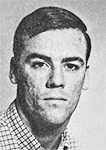A Writer Writes — Death at Tinta by Michael J. Beede (Peru)
DEATH AT TINTA
By Michael J. Beede (Peru 1963-64)
•
At dawn on February 4, 1964, my partner Ron Arias (Peru 1963-64) and I left our home base in Sicuani, Peru. We were headed for Tinta, 17 miles away, a small nearby town in the Quechua-speaking boondocks three hours south of Cuzco. It was to be a routine inspection trip to monitor the distribution of USAID food in the rural schools enrolled in the government’s school lunch program. Nothing out of the ordinary was expected.
 At the time, Ron and I had the use of a Peace Corps Jeep to visit these rural areas. That morning I was driving our pastel blue Peace Corps Jeep with Ron riding shotgun. We stuck out like a sore thumb, an inviting target for mischief.
At the time, Ron and I had the use of a Peace Corps Jeep to visit these rural areas. That morning I was driving our pastel blue Peace Corps Jeep with Ron riding shotgun. We stuck out like a sore thumb, an inviting target for mischief.
A fine powder billowed up from the unpaved dirt road filling the cab with a choking cloud of dust. I fought to maintain control of the vehicle feeling every jolting bump of the washboard road through the steering wheel. We were doing our best to endure the bone-jarring, dusty ride. The glorious Andean sunrise promised a beautiful new day ahead. The weather was clear and all was well. Or so it seemed. There was no way either of us could have been prepared for the horror that lay in wait just down the road we traveled.
Ron and I had trained together for the Peace Corps. He spoke fluent Spanish, was of Latin ancestry, and had lived and worked in Latin America. I was the rookie and it was all new to me. There had been reports in the press of growing indigenous campesino (peasant farmer) unrest across Peru’s Andean regions. It finally exploded into violence in the Tinta District where we were now headed.
We had just crossed the railroad tracks that separated the town of Tinta from the main road to Cuzco. In the distance, we could see a growing angry mob of flag-waving campesinos intent on cutting off our approach to the town. Alarmed by the unusual sight moving towards us, we stopped to try and make out what was happening. Suddenly, all hell broke loose.
“They’re trying to outflank us and cut us off before we can get back across the tracks,” Ron shouted as the approaching mob began to surround us.
“No shit, Sherlock,” was my reply as I jammed the Jeep into reverse and put the pedal to the metal. We fled for our lives back across the railroad tracks and on to the rutted excuse for a road that we had come in on.
Once on the other side of the tracks, I spun the vehicle around and raced for the main road back to Sicuani as the angry mob was closing ranks around us. It was the only escape open to us and we made it by the skin of our teeth.
We learned that later that morning, after our unceremonious departure from the Tinta District, that members of the local police and Peru’s Guardia Civil had arrived. They brutally attacked the several hundred campesinos gathered to protest attempts to evict them from ancestral lands they had recently reclaimed. The two opposing groups met at the Hacienda Belenpampa outside of the small town of Tinta on the road above the railroad tracks we had just crossed. The encounter soon turned tragic with the well-armed police and Guardia Civil opening fire on the defenseless campesinos armed only with shovels, rocks, and their bare hands.
It was a massacre with 18 campesinos dead and 25 wounded. Hundreds of campesino men and women were condemned to serve long prison terms and hauled off to jails and prisons scattered around the country.
When we returned to Sicuani later that afternoon, we passed by the hospital near the railroad tracks at the entrance to town. Closer inspection revealed a shocking sight. There was a railroad flat car on the siding in front of the hospital loaded with the lifeless bodies of campesinos stacked up like cordwood. We stopped to ask the American Papal Volunteer nurses who worked at the hospital what had happened.
The nurses told us that the dead and dying casualties had been arriving all afternoon. They were the victims of a violent encounter with the police and military that day in the District of Tinta.
Ron and I realized then that early that morning we had narrowly escaped getting trapped in this deadly confrontation. The opposing forces of mestizo (people of mixed ancestry of Spanish adventurers mating with Indigenous women) landowners backed by military might attacked a poor unarmed group of indigenous campesinos protesting their eviction from lands their ancestors had farmed for centuries.
It was a stark eye-opening beginning in our efforts to fathom Peru’s deep divides between the powerful and the powerless. How would it even be possible to bridge those gaps,

Good question Michael. One which those PCVs who lived through the Civil War in Guatemala also ask. Unfortunately, in the case of Guatemala the divides have deepened and the violence continues.
Thanks for sharing.
Mark
Gripping moment in the life a a PCV and a harsh eye-opener to reality. Gracias, amigo, Rob
Good job, in capturing a scary and tragic episode we both witnessed.
Nice job, my Brother!
I remember those days as I was also in the area. I encountered those inequities in the area around Abancay,Peru, 8 hours west of Cusco in 1965. I describe a meeting of indigenous people with the authorities in the chapter “The Potato Caper” in my book, Between Inca Walls, A Peace Corps Memoir. My situation involved guns, but luckily not a massacre.
You were fortunate to get out of that alive. I had my own adventures in Peru while serving as a PCV in Chile (1963-65) and later in Peru as a visiting scholar working on my PhD dissertation (1969) and again in the early 90s with US/AID. I managed to incorporate many of these into my fiction book (Lily of Peru) which won a number of prestigious literary awards.